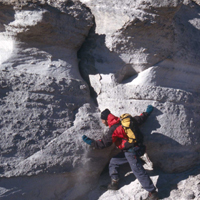
Scientific Overview

Nunavut 2007 Home
Expedition Itinerary
Expedition Members
Polar Dinosaurs
Scientific Overview
Sponsorship
Our expedition seeks to expand our knowledge of ancient terrestrial ecosystems at times of dramatic climatic change. The research will explore rocks that record terrestrial fossils that lived at times preceding the climate changes. This data is vital to begin to assess how these terrestrial ecosystems changed in response to climatic changes, and how they may change in the future as the Earth experiences much warmer conditions due to human induced greenhouse gas production.
Our primary study sites for this expedition
is Bylot Island, Nunavut. Bylot Island has been known for some time
to have fossil localities. Previous expeditions by Larsson and Rybczynski
have found diverse vertebrate fossil material including dinosaurs,
birds and marine reptiles. However, previous expeditions' lack time,
scope and focus on this productive locality. It is therefore our intention
to thoroughly document the totality of fossils from this area of Bylot
Island.
Our second intended study is a relatively unexplored area of Baffin
Island, near Pond Inlet. This area's geology indicates that there
is a good chance fossil material from the Mesozoic has been preserved.
However, no palaeontological expedition has ever been mounted to examine
this potentially important site.
Our ongoing group project is investigating in detail the biodiversity, productivity and provinciality in the Canadian Arctic during this time. Most of the data we have for the Arctic during this period comes from Alaska, Siberia and Greenland, while the number of fossils recovered from the Canada is extremely small. The main reason for this is not the lack of fossils in the area, but rather a lack of search effort, and so our goal is to change this.
By combining the data from productivity and
diversity we hope to gain a more precise understanding of the ecological
trends occurring across North America in the plant community at this
time, such as provinciality and the floral response to long-term climatic
changes on the order of millions of years. As well, questions about
long-term changes in global temperatures at high latitudes can be
examined.
![]()